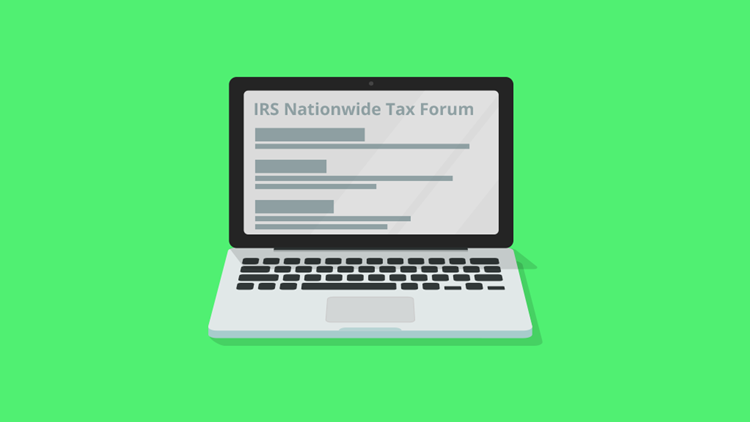by | Mar 5, 2022 | Tax Tips and News
Tax season may be far from over in 2022, but it’s not too early to make plans to attend this year’s IRS Nationwide Tax Forums, starting in July.
The event is seen throughout the income tax industry as the marquee outreach event for tax professionals, state and federal tax agencies and tax industry leaders. Historically, the forums have taken place in a number of cities around the country each summer, although the traveling venue format was interrupted by the COVID pandemic.

This year’s format follows a similar arrangement from 2020 and 2021, using a virtual environment and lived-streamed webinars. The Nationwide Tax Forum opens July 19 and continues through August 18. Live streamed webinars are available on Tuesdays, Wednesdays and Thursdays.
This year’s virtual event includes:
- A keynote address from Commissioner Charles Rettig;
- A plenary session with tax law and publications updates, and
- Multiple sessions on high-interest topics for the tax professional, with presentations by both IRS experts and partner associations.
Course details will be announced soon, along with webinar titles, descriptions and schedules.
Registration for the IRS Nationwide Tax Forums
Registration is now open for the 2022 IRS Nationwide Tax Forums. Tax pros are advised to register early for the best experience. Fully registered attendees get to take part in all the live webinars, visit the vendors in the Virtual Expo, and share their experiences in choice focus groups.
Attendance at the 2022 event also qualifies a tax professional for continuing education (CE) credits. This includes enrolled agents, certified public accountants, Annual Filing Season Program participants, California Tax Education Council (CTEC) participants and Certified Financial Planners (CFP).
Participants will have to abide by their respective licensing agency’s CE requirements.
For those who can’t attend this 2022 virtual main event, the IRS Nationwide Tax Forums Online (NTFO) has courses based on taped seminars from previous Tax Forums. The NTFO courses can be taken for CPE credit or for audit purposes.
It should be noted, however, that registration for NTFO is separate from registration for the IRS Nationwide Tax Forum.
Have questions about the 2022 IRS Nationwide Tax Forums? Email taxforums@irs.gov.
Come see us at the Tax Forums!
Be sure to visit the Drake Software virtual booth if you attend this year. We look forward to interacting with you!
Source: “IRS Nationwide Tax Forums Information“
– Story provided by TaxingSubjects.com
by | Mar 5, 2022 | Tax Tips and News
IRS Highlights Gig Economy, Virtual Currency, and Foreign Source Income
Some new sources of income sometimes go where tax law hasn’t gone before. This leads to income slipping through the cracks for a while until the law catches up.
The IRS wants taxpayers to know that in the areas of gig economy income, virtual currency and income from foreign sources, the cracks are disappearing.
That said, the Internal Revenue Service is also posting reminders and tools on its website that can help taxpayers stay abreast of their reporting responsibilities.

Reminder 1: Gig Economy Income is Taxable
As a rule of thumb, income generated in the gig economy—whether a full-time job or just a side hustle—is taxable and needs to be reported. Just because the work comes to the taxpayer through digital means such as an app, doesn’t mean it’s not income. Such income must be reported, even if it is:
- From part-time, temporary or side work,
- Not reported on an information return form – like a Form 1099-K, 1099-MISC, W-2 or other income statement or
- Paid in any form, including cash, property, goods or virtual currency.
The IRS’ gig economy tax center on its website has more good information on the gig economy.
Reminder 2: Virtual Currency Gains are Very Real Income
Virtual currency is now front-and-center in the IRS sights. At the top of the Form 1040 and the Form 1040-SR asks if the taxpayer has any virtual currency transactions. The answer is either a “yes” or a “no,’ so the answer should be carefully considered.
A reportable transaction with virtual currency includes the following types, but isn’t limited just to these examples:
- The receipt of virtual currency as payment for goods or services provided;
- The receipt or transfer of virtual currency for free (without providing any consideration) that does not qualify as a bona fide gift;
- The receipt of new virtual currency as a result of mining and staking activities;
- The receipt of virtual currency as a result of a hard fork;
- An exchange of virtual currency for property, goods or services;
- An exchange/trade of virtual currency for another virtual currency;
- A sale of virtual currency; and
- Any other disposition of a financial interest in virtual currency.
The IRS has a couple more heads-up hints that can help those taxpayers with virtual currency to report.
If any virtual currency held as a capital asset was disposed through a sale, exchange or transfer, the taxpayer should answer the question with a “yes” and figure a capital gain or loss on Form 8949 and report it on Schedule D (Form 1040).
Taxpayers who receive virtual currency as pay for services rendered – or who disposed of virtual currency they had for sale as part of a trade or business – also have to report the income just as they would if the crypto were conventional currency.
This means reporting W-2 wages, for example, on Form 1040 or Form 1040-SR, or reporting inventory or services on Schedule 1.
The instructions for Form 1040 have more on virtual currency, as does the virtual currencies webpage on IRS.gov.
Reminder 3: Report Income from Foreign Sources
Another rule of thumb, this time for U.S. citizens and resident aliens alike: Generally, worldwide income earned by these two groups of taxpayers is subject to U.S. income tax, no matter where they live. They also have the same income tax filing requirements as someone living within the U.S.
What’s on the table for those taxpayers living abroad?
Unearned income: any interest, dividends or pensions from sources other than the U.S. The only exception is if unearned income is from a country specifically exempted from such tax by law or tax treaty.
Earned income: this includes wages and tips received from foreign sources.
The IRS reminds that even if the taxpayer qualifies for tax benefit such as the Foreign Earned Income Exclusion or the Foreign Tax Credit, which can reduce or even eliminate the taxpayer’s tax liability, they still have requirement to file.
Taxpayers who have both their tax home and their residence outside of the U.S. and Puerto Rico get an automatic 2-month extension of time to file. However, even with this extension, those taxpayers living abroad will have to pay their tax due by April 18 or face interest charges.
Special rules apply to members of the U.S. military serving abroad. See Instructions for Form 1040 and 1040-SR, Publication 54, Tax Guide for U.S. Citizens and Resident Aliens Abroad, and Publication 519, U.S. Tax Guide for Aliens.
Reporting Foreign Accounts
American citizens and resident aliens also have a requirement to report their income from foreign sources such as trusts, bank accounts or other foreign accounts – even if the taxpayer lives in the U.S. Schedule B is used to report the existence of foreign accounts and usually requires disclosure of the country where the account is held.
Some taxpayers may have to attach Form 8938, Statement of Foreign Financial Assets to their tax return along with the Schedule B. This form is used by citizens, resident aliens and some nonresident aliens when the total value of their foreign financial assets are above certain limits.
When taxpayers have an interest in foreign financial accounts – or other authority over them – and the accounts had a total value more than $10,000 at any time during 2020, they have to file a form with the Treasury Department. The Financial Crimes Enforcement Network (FinCEN) Form 114, Report of Foreign Bank and Financial Accounts (FBAR) has to be filed electronically.
More information on all these foreign income filing requirements can be found in the Tax Time Guide series and Publication 17, Your Federal Income Tax.
Source: Tax Time Guide: IRS reminds taxpayers to report gig economy income, virtual currency transactions, foreign source income and assets
– Story provided by TaxingSubjects.com
by | Mar 2, 2022 | Tax Tips and News
“Just when I thought I was out, they pull me back in.”
– Michael Corleone, The Godfather: Part III
It turns out the Internal Revenue Service isn’t entirely done with facial recognition software after all. While the agency once again confirmed they will not require biometric data for IRS Online Account registration, it would remain an option for taxpayers who prefer that verification method—with additional security measures in place to protect taxpayers’ privacy.

On February 7, the IRS announced that it would “transition away from using a third-party service for facial recognition to help authenticate people creating new online accounts.” At the time, the agency noted that this transition would involve finding a new default security process that does not raise the same privacy concerns as requiring taxpayers to submit a selfie. Last week, the agency announced a “short-term solution.”
“Taxpayers will have the option of verifying their identity during a live, virtual interview with agents; no biometric data—including facial recognition—will be required if taxpayers choose to authenticate their identity through a virtual interview,” the IRS confirmed. These interviews will be the default authentication method for the tax-year 2022 filing season, but “the IRS will work closely with partners across government to roll out Login.Gov as an authentication tool … with the goal of introducing this option after the 2022 filing deadline.”
However, critics of third-party facial recognition software may not be satisfied that this method is still available, even if it’s purely optional. To address those concerns, the IRS noted that the service provider would be required to delete all images that are used for verification after the account has been created. Further, images that were received before the agency stopped requiring facial recognition “will also be permanently deleted over the course of the next few weeks.”
Source: “IRS Statement — New features put in place for IRS Online Account registration; process strengthened to ensure privacy and security,” IRS.gov
– Story provided by TaxingSubjects.com
by | Mar 1, 2022 | Tax Tips and News
The Internal Revenue Service has published a new set of frequently asked questions on the Premium Tax Credit, giving taxpayers the latest and best information on how—and why—to claim the credit.
Start with the basics
The Premium Tax Credit is aimed at low- or moderate-income taxpayers and families who may not be able to afford health insurance that is sold through the Health Insurance Marketplace (also known as the Exchange).
Credit amounts are based on a sliding scale: the lower the income of the qualifying taxpayer, the higher the credit amount available to help cover the cost of their health insurance.
When taxpayers sign up for health insurance through the Marketplace, they can choose to have the Marketplace figure an estimated credit, which will be paid to the insurance company directly to lower what the taxpayer has to pay for their monthly health care premiums.
The taxpayer has the option to have these advance payments made for them by the Marketplace. If that’s the case, the taxpayer will have to reconcile the amount of advance credit they got with the actual credit amount when they file their tax return for the year.
Whether or not direct payments were authorized, the taxpayer fills out Form 8962, Premium Tax Credit (PTC) and sends it to the IRS with their income tax return.
The Premium Tax Credit is refundable, which means the taxpayer can receive the difference between the amount of the credit and their tax due as a refund. Even if the taxpayer doesn’t owe any tax, they may still qualify to get the entire credit amount refunded.
Updating the FAQs
The IRS has published the updated frequently asked questions surrounding the Premium Tax Credit in Fact Sheet 2022-13, found on the IRS website.
The new and improved FAQs include:
- Updated The Basics FAQs: Q1, Q3, Q4
- Updated Eligibility FAQs: Q5, Q7, Q8, Q9, Q11
- Updated Reporting, Claiming and Reconciling FAQs: Q24, Q26, Q27
- Updated Suspension of Repayment of Excess Advance Payments of the Premium Tax Credit (Excess APTC) for Tax Year 2020 FAQs: Q33, Q36
- New Unemployment Compensation 2020 and 2021 FAQs: Q38 through Q45
The IRS reminds that frequently asked questions are their vehicle to deliver the updated information quickly to taxpayers, but should not be relied upon for legal advice before such bodies as the Tax Court.
More information about such reliance is available.
Sources: IR-2022-44; FS-2022-13
– Story provided by TaxingSubjects.com
by | Feb 26, 2022 | Tax Tips and News
Judging from the likes of food, gasoline and other staples, it should come as no surprise that the Internal Revenue Service is revising its interest rates, starting in the second quarter of this year.
The Internal Revenue Code dictates that interest rates are to be determined quarterly, and beginning next quarter, those rates are going up. The IRS says the new rates will be:
- 4% for overpayments (3% in the case of a corporation);
- 5% for the portion of a corporate overpayment exceeding $10,000;
- 4% for underpayments; and
- 6% for large corporate underpayments.
Normally, for those taxpayers who aren’t corporations, the overpayment and underpayment rate is the federal short-term rate plus 3 percentage points.
For those taxpayers who are corporations, the standard underpayment rate has generally been the federal short-term rate plus 3 percentage points, while the overpayment rate was the federal short-term rate plus 2 points.
Big corporations, though, have had to shell out the federal short-term rate plus 5 percentage points for underpayment of tax. The rate for overpayment has been the federal short-term rate plus half a percentage point (0.5), levied on the part of a corporate overpayment that exceeds $10,000 for a taxable period.
The IRS says all the new rates were calculated from the federal short-term rate that took effect on February 1, based on daily compounding.
For more information on the new rates, look for the official announcement, Revenue Ruling 2022-05, that will be dated March 7, 2022 in the Internal Revenue Bulletin 2022-10.
Source: IR-2022-42
– Story provided by TaxingSubjects.com
by | Feb 25, 2022 | Tax Tips and News
A lot has been said and written recently about the various credits put forth to counter the economic effects of the pandemic and how they affect parents’ tax liabilities.
But what about those taxpayers whose tax picture is, one could say, a bit more fluid? The Internal Revenue Service acknowledges some parents have legal agreements covering just who claims the child on their taxes.
These parents may be divorced; they may be separated; they may alternate claiming the child on their taxes. The IRS has now issued guidance targeted to these taxpayers and their unique responsibilities.
Economic Impact Payments and the Recovery Rebate Credit
The third Economic Impact Payment (EIP) was, in reality, an advance payment of the 2021 Recovery Rebate Credit, using the taxpayer’s tax information from 2019 or 2020 to determine if they were eligible for the credit and how much they should receive.
There are a couple of extra considerations for those taxpayers who share a qualifying dependent.
If an eligible taxpayer didn’t receive a third-round Economic Impact Payment for a qualifying dependent they’ll claim on their 2021 tax return, the taxpayer can still claim the 2021 Recovery Rebate Credit—even if the other parent claiming the shared dependent already received an EIP.
Conversely, if a taxpayer got a third-round Economic Impact Payment for a dependent they will not claim on their 2021 tax return, they are not required to pay back all or part of the EIP if the information on their 2021 return indicates they should have received less.
Child Tax Credit
The IRS used taxpayers’ 2020 tax returns to determine who got the advance child tax credit payments in 2021. If the IRS had not yet processed the taxpayer’s 2020 return, the agency used their 2019 return instead.
This means that the parent who claimed a shared dependent on their 2020 return would have gotten the advance payments of the child tax credit in 2021.
The IRS says parents of shared dependents have a couple of issues to think about:
- Families who knew they would not claim a child on their 2021 return had the option to unenroll from receiving monthly payments by using the Child Tax Credit Update Portal at IRS.gov. People who did not unenroll and received monthly payments during 2021 for a child they won’t claim on their 2021 tax return could have to repay those payments when they file. They may be excused from repaying some or all of the excess amount if they qualify for repayment protection.
- An eligible parent who did not receive advance payments for a qualifying child will be able to claim the full amount of the child tax credit for that child on a 2021 tax return even if the other parent received advance child tax credit payments.
Those taxpayers who received advance credits during 2021 should compare the total amount they got with the total they are eligible to claim. An easy way taxpayers can make this comparison is to sign onto their Online Account.
Spouses should remember that if they received joint payments, they’ll have to each sign into their own online account so they can retrieve their respective amounts.
More information for parents of shared dependents can be found in the following resources:
Source: COVID Tax Tip 2022-29
– Story provided by TaxingSubjects.com









